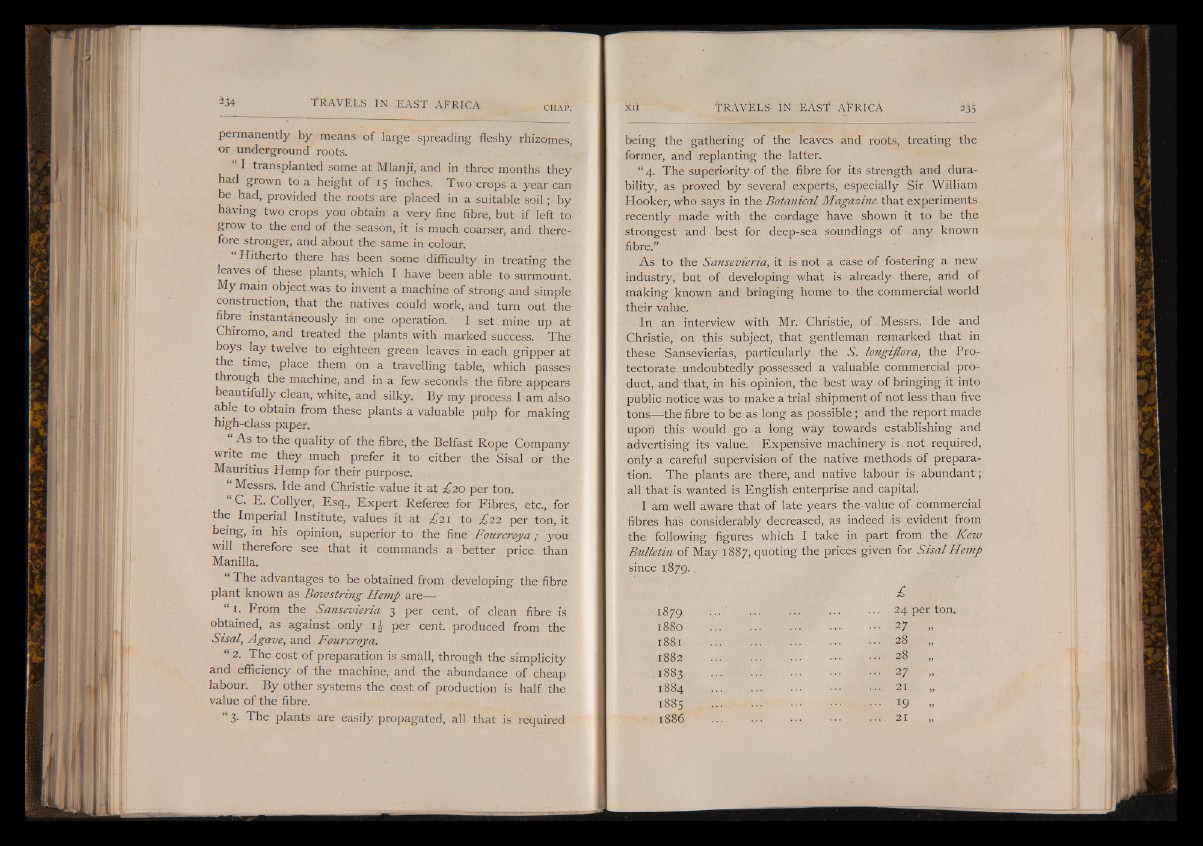
permanently by means o f large spreading fleshy rhizomes,
or underground roots.
“ I transplanted some at Mlanji, and in three months they
had grown to a height of 15 inches. Two:crops a year can
be had, provided the roots are placed in a suitable soil; by
having two crops you obtain a very fine fibre, but if left to
grow to the end of the season, it is much coarser, and therefore
stronger, and about the same in colour.
Hitherto there has been some difficulty in treating the
leaves of these plants, which I have been able to surmount.
My main object was to invent a machine of strong and simple
construction, that the natives could work, and turn out the
fibre instantaneously in one operation. I set mine up at
Chiromo, and treated the plants with marked success. The
boys lay twelve to eighteen green leaves in each gripper at
the time, place them on a travelling table, which passes
through the machine, and in a few seconds the fibre appears
beautifully clean, white, and silky. By my process. I am also
able to obtain from these plants a valuable pulp for making
high-class paper.
_ the quality of the fibre, the Belfast Rope Company
write me they much prefer it to either the Sisal or the
Mauritius Hemp for their purpose.
“ Messrs. Ide and Christie value it at £20 per ton.
“ G E. Collyer, Esq., Expert Referee for Fibres, etc., for
the Imperial Institute, values it at £21 to £22 per ton, it
in his opinion, superior to the fine Fourcroya; you
will therefore see that it commands a better price than
Manilla.
“ The advantages to be obtained from developing the fibre
plant known as Bowstring Hemp are—
“ 1. From the Sansevieria 3 per cent, of clean fibre is
obtained, as against only i-| per cent, produced from the
Sisal, Agave, and Fourcroya.
“ 2. The cost of preparation is small, through the simplicity
and efficiency of the machine, and the abundance of cheap
labour. By other systems the cost of production is half the
value of the fibre.
“ 3- The plants are easily propagated, all that is required
being the gathering of the leaves and roots, treating the
former, and replanting the latter.
“ 4. The superiority of the fibre for its strength and durability,
as proved by several experts, especially Sir William
Hooker, who says in the Botanical Magazine that experiments
recently made with the cordage have shown it to be the
strongest and best for deep-sea soundings of any known
fibre.”
As to the Sansevieria, it is not a case of fostering a new;
industry, but of developing what is already there, and of
making known and bringing home to the commercial world
their value.
In an interview with Mr. Christie, of Messrs. Ide and
Christie, on this subject, that gentleman remarked that in
these Sansevierias, particularly the S', longijlora, the Protectorate
undoubtedly possessed a valuable commercial product,
and that, in his opinion, the best way of bringing it into
public notice was to make a trial shipment of not less than five
tonsftthe fibre to be as long as possible; and the report made
upon this would go a long way towards establishing and
advertising its value. Expensive machinery is, not required,
only a careful supervision of the native methods of preparation.
The plants are there, and native labour is abundant;
all that is wanted is English enterprise and capital.
I am well aware that of late years the value of commercial
fibres has considerably decreased, as indeed is evident from
the following figures which I take in part from the Kew
Bulletin of May 1887, quoting the prices given for Sisal Hemp
since 1
18 79
1880
1881
1882
1883
1884
1
I
£
24 per ton.
27 „
28 „
28 „
27 „
21
19 »
21